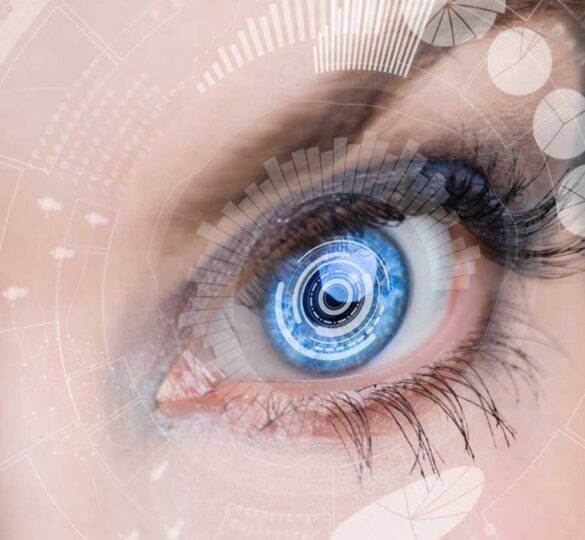Smart Contact Lenses Offer Exciting Glaucoma Breakthrough
Smart contact lenses use tiny sensors to collect data about the pressure inside your eye. They can measure and monitor changes in IOP, or provide on-demand release of glaucoma medication.

Smart contact lenses are an exciting breakthrough in glaucoma diagnosis and treatment. Over the past few years, researchers have continued developing lenses that sense and treat glaucoma, and early studies are encouraging.
Smart contact lenses use tiny sensors, like those found in smartphones and other wearable devices, to collect data about the pressure inside your eye. As a result, they accurately measure intraocular pressure (IOP), monitor changes in IOP, and could conceivably stop glaucoma-related blindness.
Smart contact lenses are called theranostic devices: a newly coined word meaning that they can diagnose and treat glaucoma. Because contact lenses can be personalized for each patient’s unique clinical needs, they may provide a promising treatment option for glaucoma.
For example, contact lens technology can be used to monitor IOP daily and detect changes before they become serious. As a result, patients with glaucoma can stop using medication when their condition stabilizes and avoid the devastating side effects resulting from too much medication over time.
The same technology could also (potentially) be used to treat glaucoma by changing the shape of the eye’s iris so that more fluid drains out of it through natural processes like blinking or washing away dirt particles with tears.
The challenge will be finding a way to make this technology affordable and accessible enough that patients can get the treatment they need. Contact lenses are expensive and only work if you wear them daily.
Smart Contact Lenses May Play a Crucial Role in Early Detection
It’s estimated that more than three million Americans have glaucoma, yet only half are aware that they have it. In addition, the most common type — primary open-angle glaucoma — has no obvious symptoms in its early stages.
Early detection is crucial because treatment options are limited once glaucoma has reached an advanced stage. The damage may be irreversible when you notice your vision getting blurry. Smart contact lenses can help patients identify problems earlier by monitoring their eye pressure and sending data from sensors embedded in the lens directly to their smartphones or computers.
How Smart Contact Lenses Detect and Monitor Glaucoma
A group of researchers from Sun Yat-Sen University in Guangzhou, China, tested an integrated wireless theranostic contact lens (WTCL). The lenses use sensing plates surrounded by ultra-soft air dielectric film that can respond to changes in intraocular pressure.
When the sensors detected a deformation in the eye’s surface due to a buildup of intraocular pressure, they sent an electrical signal that triggered the contact lens to deliver anti-glaucoma medication. The medication reduces intraocular pressure by increasing the amount of fluid that drains through the drainage canals in the eye. The anti-glaucoma medication is stored in a hydrogel layer within the contact lens.
Predicting whether a patient’s glaucoma will develop slowly or quickly is difficult. However, the use of smart contact lenses can change that. According to a study in the April 2022 edition of the Journal of Ophthalmology, electronic signals from a smart contact lens can be used to predict which glaucoma patients may have a faster advancing version of the disease.
Smart Contact Lenses May Replace Eye Drops for Some
Using daily prescriptions can be awkward, often streaming down the face instead of going into the eye. In addition, the medication can end up in places where it doesn’t help the eyes. If the drugs get into the bloodstream and travel to other organs, they can cause serious side effects. Smart lenses provide an on-demand release of glaucoma medication, making it a game changer for those who struggle with drops.
Help Us Find a Cure
The diligent work of researchers continues to lead to a better understanding of glaucoma every day. As a result, there’s great hope for new and improved treatments, including superior drug delivery methods, laser treatments, and less invasive surgical techniques. While there’s no cure for glaucoma, advancements in research, like the smart contact lens, continue to bring us closer to finding a cure and restoring vision loss from glaucoma.
Your donations of cash, stock, or a vehicle support the efforts of dedicated researchers working to find a cure for glaucoma. Every contribution helps bring us closer to finding a cure for glaucoma. You can help make it happen!
Posted December 12, 2022. This article was reviewed for medical accuracy by Sahar Bedrood, MD, PhD.

Sahar Bedrood, MD, PhD
Dr. Sahar Bedrood is a board-certified and fellowship-trained ophthalmologist in Los Angeles, California with a focus in glaucoma and advanced cataract surgery. She has an MD/PhD from Keck School of Medicine of the University of Southern California, an undergraduate degree from UCLA and surgical fellowship training from John’s Hopkins University.